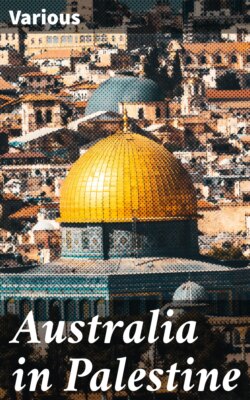Читать книгу Australia in Palestine - Various - Страница 13
На сайте Литреса книга снята с продажи.
DESERT ADVENTURES
ОглавлениеTable of Contents
No survey, however incomplete, of this fine campaign should fail to mention the countless little desert expeditions in Western and Central Sinai, in the early days of the fighting. These had various purposes. Sometimes they were political, but more than once they led to sharp fighting. The first time Australians were actually engaged east of the Canal was when the 9th Light Horse Regiment (chiefly South Australians, with a few Victorians), by a long night march and clever manœuvre, swooped down and bagged the Turkish outpost garrison at Jifjafa. Then there was a fine dash by the 11th Light Horse Regiment to Nekhl, the British pre-war administrative centre in Sinai. Later, two interesting expeditions were made up the Wady Muksheib, the ancient and central route across Sinai by which the Turks came in their feeble attack on the Canal, early in 1915. The drawback of that route was the shortage of water, and along the Wady bed some ancient power had excavated huge cisterns which filled during the rains. These cisterns are still intact. Once, the Light Horsemen pumped them out, and so closed the route for that season to the Turks; going out again, they sealed and covered them so as to make their rediscovery by the enemy very difficult.
Australian units from the Camel Brigade more than once rode across the desert to Akaba, at the head of the Persian Gulf. In October, 1916, a force marched thirty-five miles across the sandhills from Bayud to Maghara, and engaged in a vigorous reconnaissance in the foothills below the almost inaccessible, high-built Turkish garrison position. As an instance of the man-power and transport necessary to maintain a force in action on the desert for even a few days, the details of this little enterprise are remarkable. The column contained only 1100 rifles, and the operations covered but a few days; but no fewer than 7000 camels, 2300 horses and (including natives) 5000 men were employed to provide supplies of food and water for the force.
All these little side-shows necessitated long night marches across countless desert hillocks. To the untrained eye, one square mile of country in Sinai is indistinguishable from any other square mile, even by daylight. At night all movement was by compass and the stars, and the task of our guides was complicated a hundredfold by the constant change of route imposed by the steepness of many of the sand dunes. Very early the Light Horseman displayed that apparently inborn sense of direction which, almost alone, would have made him famous in this campaign. After a brief trial, the native guides provided by the Imperial authorities were found to be too slow and uncertain, while, if the enemy was close, fear usually reduced them to a state of imbecility. As soon as this was recognized, the whole of the guiding was done by our own officers, many of whom developed a certainty of location, whatever the circumstances, which amounted almost to inspiration.
